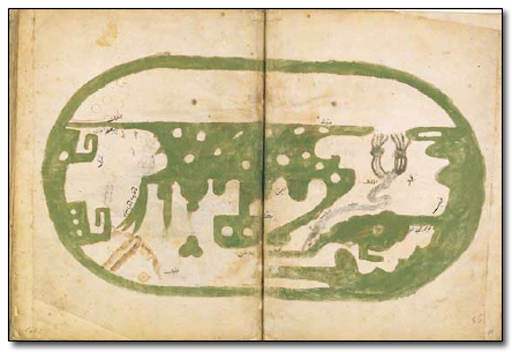Nesma Elsakaan
Beyond Ibn Hawqal’s Judgment on Palermo and Its Denizens
Nesma Elsakaan

Ibn Hawqal's world map
In 972, the Iraqi traveler, Ibn Hawqal, visited Palermo, the capital of Sicily under Kalbid rule. In his book, Kitāb al-Masālik wa-l-mamālik, he reports some aspects of the city and depicts its Muslim denizens unsympathetically, accusing them of ‘foolishness’ (naqṣ ‘uqūlihim), ‘turbulence’ (khiffat al-’admigha), and ‘bad breath’ (fasād ḥawāshīhim).[1] Ibn Hawqal was probably influenced by Islamic notions and expressions. In a forthcoming article, I examine some Muslim travelers’ accounts on Medieval Sicily.[2] I explore how their descriptions of the Sicilian landscape and people were influenced by the religion that had shaped their culture and identity. Their representations of Mount Etna, of the bodies of water and vegetation as well as the social and ethnographic dimension are permeated by references and allusions to the Islamic tradition. To address this intersection, I undertake an intertextual reading of these sources.
Ibn Hawqal’s accounts are among the most interesting narrations. He attacks Palermo and his co-religionists, although, as William Granara pointed out, Palermo was part of the nation of Islam. [3] Regardless of Ibn Hawqal’s deprecatory inferences about the place and the people, it is useful to examine the influence of both the Qur’an and Hadith on his descriptions. For example, Ibn Hawqal mentions the debauchery of al-ribāṭāt, the settlements located by the coast of Palermo. He says that they were full of ‘unemployed’(baṭṭālīn) and ‘bawdy’ men (fussāq) who were there just to beg and slander the chaste women. [4] It is interesting to highlight Ibn Hawqal’s language. He ascribes negative adjectives to the persons of al-ribāṭāt, such as ‘unemployed’ and ‘bawdy’. He also underlines their ‘self-degradation’ (mahānat al-nafs) (15). Ibn Hawqal was negatively affected by their indecent deeds, particularly towards women, which is noticeable from his use of the expression ‘slandering chaste women’ (qadhf al-muḥaṣṣanāt). This expression is a direct reference from the Qur’an; precisely, it comes from the Surah of al-Nūr in which God curses those who ‘slander chaste women’ (Q. 24:23).
Ibn Hawqal also paints a bad picture of the people of Palermo for ‘their excess in eating raw onions’, which, according to him, ‘disturbed their perception, decreased their comprehension, and altered the look of their face’ (18). It is interesting to note that there is something similar in the Hadith. According to a tradition, Prophet Muhammad dissuaded people from eating raw onion and garlic because the resulting bad breath would bother people, especially during the prayers in the mosque. Some narrations reported that the Prophet advised them to cook them and not to eat them raw. [5] Ibn Hawqal’s harsh judgment reflects the historical moment and the socio-political context in which he visited Sicily and wrote his text. Francesco Gabrieli (d. 1996) explains that when Ibn Hawqal arrived in Sicily, he judged the island, which had been Islamized for little more than a century, in comparison with ‘the great metropolises of the Islamic world and … centers of ancient Islamic civilization’. [6] Consequently, for Ibn Hawqal, the island and its Arab denizens fell short of reaching the right cultural and social standards. [7]
To conclude, Ibn Hawqal could have had other reasons (e.g. political) for his harsh criticisms. What I contend is that his comments were permeated by Islamic notions and religious terminology, which, first, could convey messages that a Muslim reader would easily recognize; second, it gives more credit to his accounts. The encounters of Muslim travelers with ‘the other’ and their perceptions of place were interpreted through an accumulated tradition of religious, culture-based language and themes. Many ideas and discursive features flagrant in their works are both directly and indirectly derived from Islamic texts. Hence, intertextuality is a good tool to reconstruct this textual link.
Nesma Elsakaan is assistant professor of Arabic language and literature at the University of Palermo (Italy) and is a member of the Union Européenne des Arabisants et Islamisants (UEAI).
Notes
[1] Abu al-Qasim Muhammad Ibn Hawqal, al-Masālik wa-l-mamālik, in Biblioteca Arabo-Sicula, Vol. 1, comp. Michele Amari (Palermo: Accademia Nazionale di Scienze Lettere e Arti, 1988), 18. Translation from Arabic into Italian is mine.
[2] Nesma Elsakaan, ‘Arab-Muslim Accounts of Medieval Sicily and the Qur’an: An Intertextual Reading’, in Nuha Alshaar (ed.), Sicily: A Story of Cultural Encounter and Exchange from the Arabs to the Normans, Edinburgh University Press, Edinburgh, forthcoming.
[3] William Granara, ‘Ibn Hawqal in Sicily’, Alif: Journal of Comparative Poetics 3 (Spring, 1983), 94–9.
[4] Abu al-Qasim Muhammad Ibn Hawqal, al-Masālik wa-l-mamālik, 15.
[5] Hafiz al-Nisa’i, The Book of the Masjids (English translation), vol. 1, book 8, hadith no. 709, accessed 25 February 2020, https://sunnah.com/nasai/8.
[6] Francesco Gabrieli, ‘Ibn Hawqal e gli Arabi di Sicilia’, Rivista degli Studi Orientali 36 (1961): 251. Translation from Italian into English is mine.
[7] For more about Ibn Hawqal’s motivations and judgment, see ibid., 251–3.
Back to Meridian 1:2

